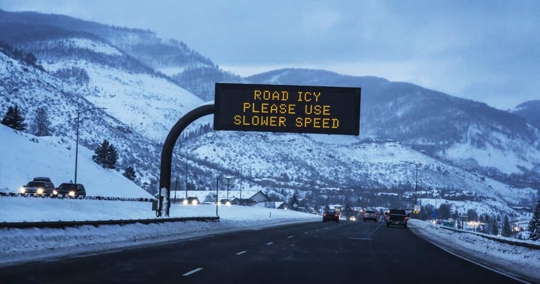Colorado's beautiful winters often come with a hidden danger that can affect even the most cautious drivers: black ice. Invisible to the eye, black ice can make roads unexpectedly slick and hazardous, leading to serious crashes in a split second.
Learn how Gaddis, Herd, Craw & Adams, P.C. can help you recover compensation for your injuries, medical bills, lost wages, and other damages, how to stay safe on wintery roads, and what to do if you’ve been involved in a black-ice accident.
What Makes Black Ice Dangerous?
Black ice is unique because it is almost impossible to detect while driving. Unlike visible snow or sleet, black ice forms without air bubbles, giving it a transparent appearance that blends seamlessly into the road surface. Often, the only indication of black ice is a shiny patch on an otherwise dull-colored roadway, but that can be hard to spot, especially in low-light conditions like early morning or evening.
These invisible hazards can appear anywhere but are often found on bridges, overpasses, shaded roads, and less-traveled areas. The unpredictable nature of black ice makes it one of the most dangerous road conditions during Colorado winters.
How Gaddis, Herd, Craw & Adams, P.C. Can Support You
Accidents caused by black ice often result in serious injuries and complex insurance claims. Proving negligence in these cases can be challenging, as road conditions themselves might seem like the only culprit.
However, other factors may contribute to these accidents, including:
- Neglected road maintenance can leave surfaces uneven, cracked, or without proper treatment, such as sanding or salting, making black ice more hazardous.
- Insufficient signage in high-risk areas like bridges or overpasses fails to warn drivers about potential black ice patches.
- Poor lighting or visibility along roads can make it harder for drivers to detect subtle visual signs of black ice.
- Reckless driving behaviors, such as speeding or tailgating, drastically increase the risk of losing control on icy roads.
- Drivers failing to adapt their speed or braking method to winter road conditions may inadvertently cause or worsen accidents on black ice.
- Vehicles with worn or inadequately maintained tires provide less traction, escalating the risk for everyone on the road.
- Improperly plowed roads can leave thin layers of snow that compact into black ice, increasing the risk when temperatures drop further.
At Gaddis, Herd, Craw & Adams, P.C., our attorneys will thoroughly investigate your crash to determine fault and build a strong case on your behalf. We can assist in holding responsible parties accountable, whether it’s another driver, a government entity responsible for road upkeep, or another liable party. Our focus is on securing the maximum compensation you deserve.
How to Stay Safe When Driving on Black Ice
While some accidents are unavoidable, taking precautions can reduce your chances of losing control on black ice.
Keep these tips in mind when driving in icy conditions:
- Drive Slowly – Reduce your speed to maintain better control. Ideally, keep speeds under 45 mph in icy conditions, or slower depending on road traction.
- Avoid Sudden Movements – Gradually decelerate by easing off the gas; slamming the brakes can cause skidding. If you have paddle shifters, use them to slow down.
- Use Traction Wisely – Try to drive on textured surfaces like gravel for extra grip, particularly if your vehicle lacks 4WD.
- Be Prepared – Identify areas where black ice will likely form, such as shaded stretches, bridges, and overpasses, and adjust your driving accordingly.
- Stay Calm – If you hit black ice, don’t panic. Keep your steering wheel straight, gently ease off the gas, and avoid pressing the brake.
What to Do If You’ve Been in a Black Ice Crash
Sometimes, no amount of preparation can entirely prevent an accident caused by black ice. When the unexpected happens, Gaddis, Herd, Craw & Adams, P.C. can step in to provide the legal support you need. With a history of successfully helping accident victims, we are ready to guide you at every step—from investigating your accident and negotiating with insurance companies to pursuing compensation in court if necessary.
Contact our team at today to discuss the details of your case.

